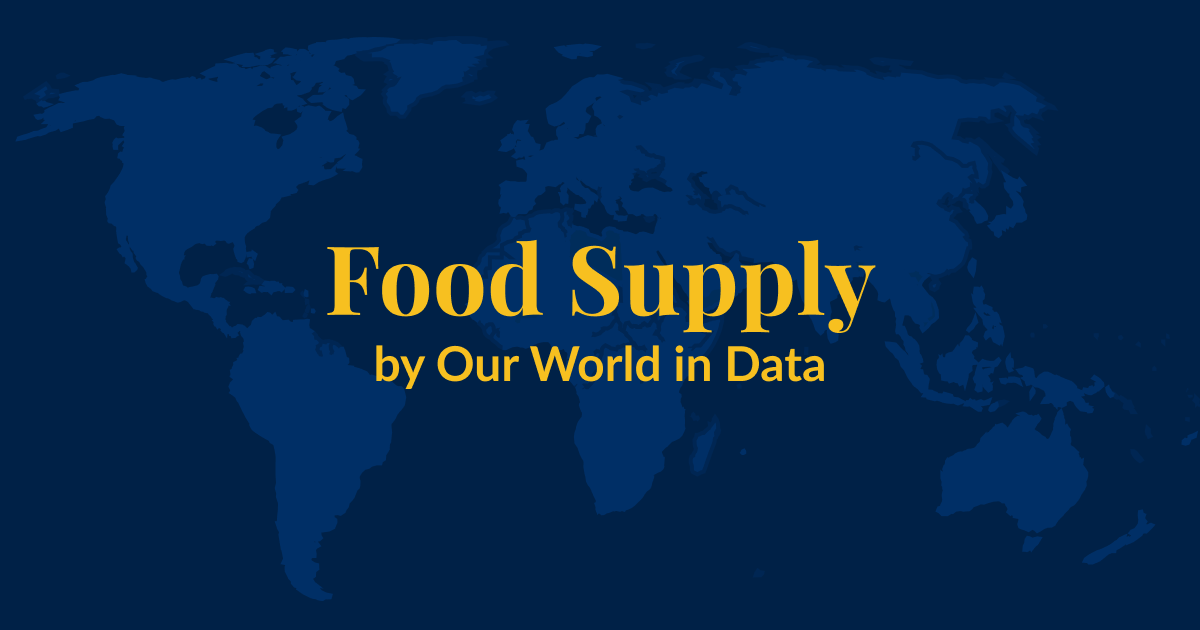Daily supply of calories per person

What you should know about this indicator
- This data shows per capita daily calorie supply, which is the amount of calories available to an average person, and does necessarily correspond to the calories actually consumed by that person.
- Calorie supply is always larger than actual calorie consumption, since there may be waste at the household level.
- For historical data, daily calorie supply and consumption are sometimes used interchangeably, due to poor data availability.
- This data does not give a complete picture of nutrition - for a healthy diet we need much more than just energy. But as the most basic criteria of food security, getting enough calories is an important measure. It is used as input for the most important metrics used to assess global malnutrition: undernourishment.
Related research and writing
Sources and processing
This data is based on the following sources
How we process data at Our World in Data
All data and visualizations on Our World in Data rely on data sourced from one or several original data providers. Preparing this original data involves several processing steps. Depending on the data, this can include standardizing country names and world region definitions, converting units, calculating derived indicators such as per capita measures, as well as adding or adapting metadata such as the name or the description given to an indicator.
At the link below you can find a detailed description of the structure of our data pipeline, including links to all the code used to prepare data across Our World in Data.
Notes on our processing step for this indicator
- For all countries, the data after 1960 is taken from FAOSTAT Food Balances datasets (old and new methodologies combined).
- For the UK: We load Appendix Table from Harris et al. (2015). From that table, we select values from Broadberry et al. (2015) and the corrected values from Floud et al (2011) (taking the average value of Estimates (A) and (B)).
- For the US: For years 1800-1900, we use Table 6.6 of Floud et al. (2011). For years 1900-1960, we use the archived table of food supply from USDA.
- For Iceland: We use Table 5 of Jonsson (1994).
- For Finland, Germany, Italy, Norway: We use Table 1 from Grigg (1995), which is a compilation of many sources.
- For France: We use Table 1 from Grigg (1995).
- We include the two additional data points (1705 and 1785) from Fogel (2004).
- For Belgium and Netherlands: We use Table 5.5 of Floud et al. (2011).
- For Uganda, Cambodia, China, India, Brazil, Mexico, and Peru for 1936 and 1947: We use Table 11 of FAO (2000) (The State of Food and Agriculture).
- For many countries (including some of the above) for 1947 and 1948: We use values from Table 15 from FAO (1949).
- Note that prior to 1961, data for the UK may correspond to England, or England and Wales; and Tanzania refers to Tanganyika.
Reuse this work
- All data produced by third-party providers and made available by Our World in Data are subject to the license terms from the original providers. Our work would not be possible without the data providers we rely on, so we ask you to always cite them appropriately (see below). This is crucial to allow data providers to continue doing their work, enhancing, maintaining and updating valuable data.
- All data, visualizations, and code produced by Our World in Data are completely open access under the Creative Commons BY license. You have the permission to use, distribute, and reproduce these in any medium, provided the source and authors are credited.
Citations
How to cite this page
To cite this page overall, including any descriptions, FAQs or explanations of the data authored by Our World in Data, please use the following citation:
“Data Page: Daily supply of calories per person”, part of the following publication: Max Roser, Hannah Ritchie and Pablo Rosado (2013) - “Food Supply”. Data adapted from Food and Agriculture Organization of the United Nations, Harris et al., Floud et al., Jonsson, Grigg, Fogel, USDA Economic Research Service (ERS). Retrieved from https://ourworldindata.org/grapher/daily-per-capita-caloric-supply [online resource]How to cite this data
In-line citationIf you have limited space (e.g. in data visualizations), you can use this abbreviated in-line citation:
Food and Agriculture Organization of the United Nations (2023) and other sources – with major processing by Our World in DataFull citation
Food and Agriculture Organization of the United Nations (2023); Harris et al. (2015); Floud et al. (2011); Jonsson (1998); Grigg (1995); Fogel (2004); Food and Agriculture Organization of the United Nations (2000); Food and Agriculture Organization of the United Nations (1949); USDA Economic Research Service (ERS) (2015) – with major processing by Our World in Data. “Daily supply of calories per person” [dataset]. Food and Agriculture Organization of the United Nations, “Food Balances: Food Balances (-2013, old methodology and population)”; Food and Agriculture Organization of the United Nations, “Food Balances: Food Balances (2010-)”; Harris et al., “How Many Calories? Food Availability in England and Wales in the Eighteenth and Nineteenth Centuries”; Floud et al., “The Changing Body”; Jonsson, “Changes in food consumption in Iceland, 1770-1940”; Grigg, “The nutritional transition in Western Europe”; Fogel, “The Escape from Hunger and Premature Death”; Food and Agriculture Organization of the United Nations, “The State of Food and Agriculture 2000”; Food and Agriculture Organization of the United Nations, “The State of Food and Agriculture 1949”; USDA Economic Research Service (ERS), “U.S. food supply: Nutrients and other food components, per capita per day” [original data]. Retrieved July 27, 2024 from https://ourworldindata.org/grapher/daily-per-capita-caloric-supply






